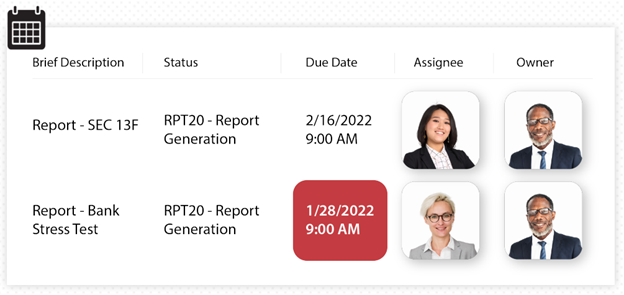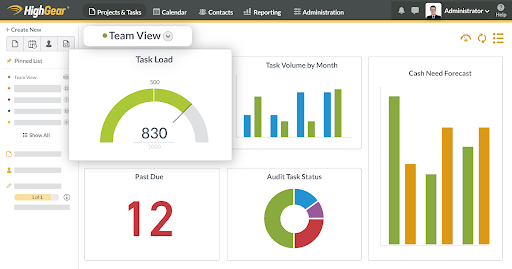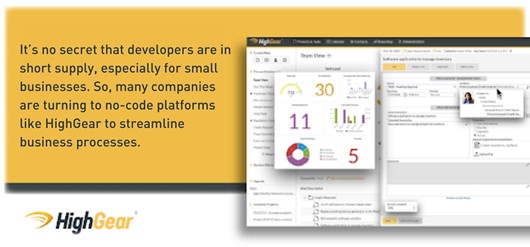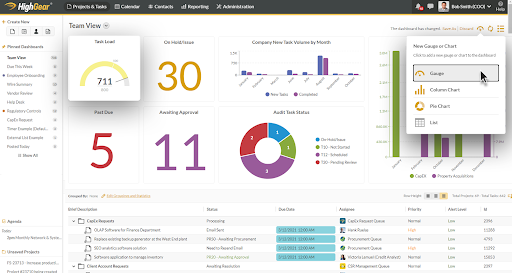
A key to deploying workflow automation and achieving successful outcomes for many of those organizations began with their depth of scrutiny and rigor applied during the software evaluation phase. However, finding and implementing the right software can be expensive, time-consuming, and overwhelming. It takes engaging the right team members and stakeholders at the right time, understanding their constraints, and foreseeing future bottlenecks that can render a new software unusable. Not everyone has access to well-developed roadmaps or detailed specification lists to follow during that process. That’s where HighGear’s “buyer’s guide” with nearly 200 critical specifications can make this process more time and cost-effective.
This critical requirements document, available to those who schedule a free demo with us here, provides an in-depth review of 6 important categories to consider in the decision-making process. These include:
1. Task Management and Workflow Coordination
2. Work Prioritization and Escalation
3. Project Management
4. Information Tracking
5. Communication and Accessibility
6. Technical Specifications
Within each of these areas, the full “buyer’s guide” provides an exhaustive list of functionality that should be present in any robust, enterprise-grade solution. It also includes mandatory requirements that we’ve found to be essential for any company to widely benefit from workflow management software at scale. 24 of the most critical/mandatory specification components are listed below.
TASK MANAGEMENT AND WORKFLOW COORDINATION
1. Work, Request, and Issue Management System – System shall be capable of maintaining a permissions-enabled list of current work items (open tasks, requests, actions, projects, process instances, open issues, recorded suggestions, etc.), easily grouped by status or any other meaningful attribute.
2. Workflow – System shall be capable of maintaining a permissions-enabled list of current work items (open tasks, requests, actions, projects, process instances, open issues, recorded suggestions, etc.), easily grouped by status or any other meaningful attribute.
3. Field Permissions – System shall support the setting of permissions on built-in and custom fields. Permissions shall at least include read/write, read-only, and no access. The permissions shall be enforced throughout the system, including but not limited to task lists, forms, and reports. Permissions may be able to be applied to users or permissions groups (such as Clients, Employees, Engineering Team, Human Resources Staff, Human Resources Managers, etc.)
4. Automate Workflows – System shall be capable of processing a constant workflow plan, so that after each individual is finished performing their given task, the system will assign the issue to the next team, queue, or individual concurrently and automatically, so that the next task can be quickly seen and undertaken.
5. Constant Chain of Custody – System shall be capable of assigning an issue to a designated individual, Organizational Unit, or Queue, or group of same, for each step in the process. System shall be capable of transferring custody of a work item, project, or issue from one worker to another smoothly – and proper access to the task, related data and attachments shall automatically transfer as well, without violating field-level permissions.
6. Activity Log/Audit Trail – System may be capable of maintaining a log or audit trail of all activity performed to the work item (issue). The log may record both the time/date of the activity, the actor, and a description of the activity performed.
7. Value Recording/Historical Integrity – System may be capable of processing a constant workflow plan so that after each individual is finished performing their given task, the system will assign the issue to the next team, queue, or individual concurrently and automatically, so that the next task can be quickly seen and undertaken.
8. Due Date Display – Due dates for each task shall be prominently displayed. Due and overdue tasks shall be color-coded for easy identification. Projects containing due or overdue tasks shall be color-coded to reflect the highest needed attention level for problem tasks within the project and/or sub-projects’ tasks.

PRIORITIZATION
9. Input – When a work item (an issue) is initiated, the system shall be able to accept and record one or more metadata values to represent prioritization.
10. Priority Number Dashboard Display – System shall be able to display project or task priority ranking on the homepage/dashboard screen.

11. Escalation – System may have the capability to escalate an issue after a set period of time.
PROJECT MANAGEMENT
12. Periodic Work Reports – System shall be able to report the total number of new issues and/or number of tasks completed to managers and other users.
13. Time Tracking – System shall be capable of recording a system-generated timestamp that will record when a task (or a stage of a workflow) has been completed.
INFORMATION TRACKING
14. Upload Capability – System shall be capable of receiving uploaded documents.
15. Search Capability – Software shall have the ability to search through previously resolved issues/cases.

COMMUNICATION AND ACCESSIBILITY
16. Contact Data Customization – System shall support the addition of custom fields for contacts, organizational units, and assets.
17. Local Login – The system shall have the capability to add users that are not LDAP/Active Directory enabled and grant them login rights based on a local or system-specific account.
TECHNICAL SPECIFICATIONS
18. Browser Compatibility – System shall be accessible from any operating system capable of running a modern browser, including mobile devices.
19. Installation – System shall not require the installation of any client-side software (other than a supported browser).
20. Agility – System rules and workflow processes shall be reconfigurable by an administrator without requiring downtime.
21. Report Export – System shall be able to export reports.
22. Report Visualizations – System shall enable data to be visualized using pie charts, bar charts, line charts, area charts, tables, crosstab tables, and various interactive and graphical outputs that facilitate intuitive decision support and trend analysis.
23. Report Datasets – System shall enable multiple datasets to be analyzed on one report and shall provide access to Performance Data, Time Tracking Data, Productivity Data, Asset Data, and Contact Data. System shall support customizable runtime parameters (such as user-selectable date ranges, teams, task types, or other custom parameters that can be selected by an end-user when they desire to run a report.
24. Training – Training shall be made available to the client in real-time. The vendor shall include a description of training recommended or required with system purchase (included in pricing).
Beyond the nearly 200 point specifications in the full buyer’s guide, it’s important to consider who will be responsible for successfully deploying workflow processes and the system at large and what resources are available for execution. It’s no secret that developers are in short supply, especially for small businesses. So, many companies are turning to no-code platforms like HighGear to streamline business processes.
As part of the evaluation process, companies will also want to consider whether their potential software partner will require any coding or in-depth technology support from in-house teams. With more teams working remotely, it’s possible that a system can be deployed by everyday business users who are technically savvy and creative – especially if the prospective supplier can effectively provide feature-rich user interfaces and hands-on, human-to-human support when needed.

Software evaluation can be a complex and daunting task. But with the right partner, tools, and information in hand, it doesn’t have to be. Reach out to talk to us about how we can simplify your software evaluation and for your copy of our nearly 200 point specification tool. In the meantime, you can take advantage of our downloadable version of the 24 mandatory requirements that should be present in any useful workflow automation software and business process management solution.

